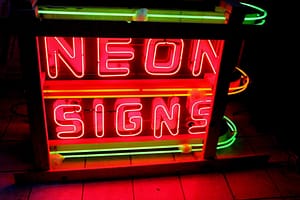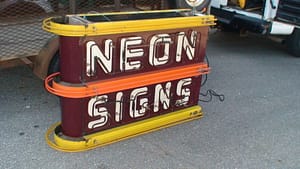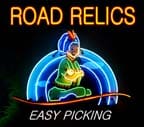The History of Vintage Neon Signs
by Darryl Tilden
History of Neon Signs. In 1675 the Theory of Neon was born. It was in the age before electricity and a man named Jean Picard noticed that there was a faint glow in his mercury barometer specifically when it was shaken. A barometric light occurred however it was not understood at that time that it was the static electricity that caused the tube to glow. It was investigated but not understood at that time.
Years later scientists investigating the principles of electricity were able to invent many forms of lighting, hence, History of Neon Signs
DISCHARGE LAMPS WERE INVENTED AND ELECTRIFIED
A German named Heinrich Geissler was a glass blower and physicist who invented the Geissler tube. After electrical generators were invented many inventors and scientists started experimenting with a mixture of gases glass tubes and electrical power sources. Eventually, they discovered that under low pressure these gases would glow with an electric current that was applied to the tube.
After years of experimenting using many different types of discharge lamps, and vapor lamps they discovered that this lighting device that was transparent would glow when they applied electric current to a gas-filled tube. These discoveries were made both in the United States and Europe.
THE FIRST NEON LAMP INVENTOR WAS GEORGE CLAUDE, CLAUDE NEON:
“Neos” became the Greek word for neon and its meaning was “new gas“. In 1898 in London England William Ramsey and M.W. Travers discovered neon gas. It’s a rare gaseous element found in the atmosphere. There is one part neon for 65,000 parts of air. To obtain the neon from the air it went through a liquefaction of the air, then separated with a function called “fractional distillation” and this separated the neon from the other gases.






George Claude was born on September 24, 1870, and he became an engineer, and chemist in France. He was the first person to apply an electrical discharge to a sealed tube of neon gas to create a lamp. On December 11, 1910, he first displayed it to the public. He then patented January 19, 1915. U.S.Patent # 1,125,476
Claude Neon, his French Company name sold the first neon sign to “Packard Motor Company” in 1923 for a staggering price of $24,000. Earl C. Anthony was the owner of this Packard Dealership in Los Angeles California. People from all around the country came to visit this new attraction of the first “NEON SIGN”.
NEON SIGNS BECOME VERY POPULAR :
The public was amazed at the sign that could be seen glowing in the daylight. It was nick nicknamed liquid fire and became very popular for indoor and outdoor signs.
PRODUCTS USED TO MAKE A NEON SIGN
The first step in making neon tubes is to buy a nice neon plant & I have a great Daco system for sale. It’s top-of-the-line and you can pump up to 4 units at a time. The next step is to get raw tubing which comes in different lengths of sticks and the most common is 4′.Then you will need torches, mercury, electrodes, and other miscellaneous supplies. There are several types of glass compositions, soft glass lead glass, soda lime glass, and barium. Hard glass from the borosilicate family is also used. First, the glass is heated with specific torches using forced air with lit gas. Usually, the heat range is 1600′ to 2200′ degrees Fahrenheit.
Making a NEON SIGNS
Hollow glass tubes used to make neon lamps come in 4, 5, and 8 ft lengths. To shape the tubes, the glass is heated by lit gas and forced air. Several compositions of glass are used depending on the country and supplier. What is called ‘Soft’ glass has compositions including lead glass, soda-lime glass, and barium glass. “Hard” glass in the borosilicate family is also used.
Depending on the glass composition, the working range of glass is from 1600′ F to over 2200’F. The flame is usually around 3000’F. The tubes can be cut by scoring them with a file while the tube is cold, then they are heated with specific torches and bent using a pre-drawn pattern. After bending the tubes to desired pattern it’s ready to be processed. The tube is evacuated of air and then short-circuited with high voltage bombarding until the tube reaches 550′ F. The tube is evacuated again until it reaches a vacuum of 10-3 torr. It is backfilled then with neon or an argon-mercury mixture.
Neon-filled tubes come out red in color and argon mercury comes out blue in color. They are filled to a specific pressure depending on the tube diameter and then sealed off.
There are more than 150 colors using phosphor-coated tubes filled with argon mercury.
The most vibrant and saturated colors come from a European classic stained glass that is simply beautiful, however a little more difficult to work with.
Some must-follow tips for you to purchase: History of Neon Signs!
It has been more than a decade now since neon signs have brightened the streets of the USA at night. They were first developed more than 100 years ago. Since their invention, they have always been considered as a better way to execute information in a beautiful and attractive manner.
This is what made neon signs a popular way of advertising. Various kinds of neon signs have been made since their invention and some of them have become quite popular among vintage signs collectors. This is what made many sign sellers provide
If you are one such vintage neon signs collector then you must be looking for such signs all the time. But, do you know that lots of factors are there that affect the signs? Purchasing any sign without checking those factors may cause you great loss and disappointment.
So, if you do not want to face such a situation then follow the tips given below while purchasing any vintage neon signs from the market.
Tips for buying valuable vintage neon signs
- Rarity: A more uncommon neon sign will have greater value than a common one. A neon sign is considered as rare if few are manufactured, many are manufactured but only a few have still remained, the method used for its production is complicated in comparison to its era, and the design, colors, and size are very unusual according to its time. Check all the above factors before purchasing any vintage neon sign to know how much rare it is.
- Authenticity: There are many reproduction neon signs available in the market. So, you have to do some homework before purchasing any kind of vintage neon sign. If the sign you are purchasing is not authentic then it is valueless. Various types of methods are present to make a sign look old and authentic. So, if you are not sure, please take an expert with you to check the authenticity of the signs before putting your money in it.
- Condition: No matter how collectible the neon signs are its condition has a great impact on its overall value. The conditions of the neon signs are classified into various groups. The better the condition of the signs, the more they will be valuable, and vice versa. So, checking the conditions is also important while buying vintage neon signs for sale.
- Desirability: The demand law also applies to the neon signs. The more they will be in demand; the greater will be their value and vice versa. So, check how much the neon signs are in demand before throwing your money on it.
The company that sells quality vintage neon signs
Road Relics is one of the reputed companies to provide vintage neon signs for sale. You can contact them through their online website roadrelics. They buy and sell genuine signs only. They mainly deal in signs from the late 1800’s to 1950’s. This company promises to refund the full amount along with any shipping charges if any issue is found with the signs. Some of the famous signs they deal in are old signs, antique signs, etc. To know more, feel free to check other online articles also.


